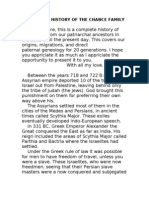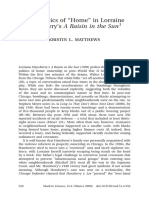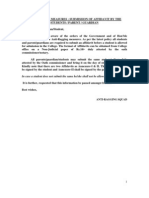100%(1)100% found this document useful (1 vote)
Zitkala Sa Q&a
Zitkala Sa Q&a
Uploaded by
Anaïs ThoresenZitkala Sa describes her childhood living freely with her tribe before being sent to a white boarding school. At school, she feels displaced from her native culture and tribe. Her hair is cut, traditional dress replaced with restrictive clothing, and Christianity taught as the dominant religion. She struggles to fit into white culture and feels torn between two worlds. After her first term away, she no longer feels at home with her tribe or among white society. She decides to return to school to gain respect from white people and overcome their prejudices against her native culture.
Copyright:
© All Rights Reserved
Available Formats
Download as DOCX, PDF, TXT or read online from Scribd
Download as docx, pdf, or txt
Zitkala Sa Q&a
Zitkala Sa Q&a
Uploaded by
Anaïs Thoresen100%(1)100% found this document useful (1 vote)
Zitkala Sa describes her childhood living freely with her tribe before being sent to a white boarding school. At school, she feels displaced from her native culture and tribe. Her hair is cut, traditional dress replaced with restrictive clothing, and Christianity taught as the dominant religion. She struggles to fit into white culture and feels torn between two worlds. After her first term away, she no longer feels at home with her tribe or among white society. She decides to return to school to gain respect from white people and overcome their prejudices against her native culture.
Original Description:
Indian childhood
Original Title
Zitkala Sa q&a
Copyright
© © All Rights Reserved
Available Formats
DOCX, PDF, TXT or read online from Scribd
Share this document
Did you find this document useful?
Is this content inappropriate?
Zitkala Sa describes her childhood living freely with her tribe before being sent to a white boarding school. At school, she feels displaced from her native culture and tribe. Her hair is cut, traditional dress replaced with restrictive clothing, and Christianity taught as the dominant religion. She struggles to fit into white culture and feels torn between two worlds. After her first term away, she no longer feels at home with her tribe or among white society. She decides to return to school to gain respect from white people and overcome their prejudices against her native culture.
Copyright:
© All Rights Reserved
Available Formats
Download as DOCX, PDF, TXT or read online from Scribd
Download as docx, pdf, or txt
100%(1)100% found this document useful (1 vote)
Zitkala Sa Q&a
Zitkala Sa Q&a
Uploaded by
Anaïs ThoresenZitkala Sa describes her childhood living freely with her tribe before being sent to a white boarding school. At school, she feels displaced from her native culture and tribe. Her hair is cut, traditional dress replaced with restrictive clothing, and Christianity taught as the dominant religion. She struggles to fit into white culture and feels torn between two worlds. After her first term away, she no longer feels at home with her tribe or among white society. She decides to return to school to gain respect from white people and overcome their prejudices against her native culture.
Copyright:
© All Rights Reserved
Available Formats
Download as DOCX, PDF, TXT or read online from Scribd
Download as docx, pdf, or txt
You are on page 1/ 4
Zitkala Sa: Impressions of an Indian
Childhood and The School Days of an
Indian Girl
1. How does Zitkala Sa describe her childhood (before
she goes off to school)?
She likes her childhood. She is free and sort of a wild child
who likes to run around and explore the nature. She is
fascinated by the elder cousin (Warca-Ziwin) and the
grandfathers. She wants to be like them.
2. How are Indian children brought up, according to
Zs memoirs? What are the values they are taught and
how are children treated? Who do the children
belong to?
The values taught are patience, tolerance, respect, hospitality
and virtue. The values taught to children reflect the way they
are treated then by the adults. The children dont belong to
anybody but their own spirit and nature.
3. How are whites described in the two texts by
Zitkala Sas mother and by Z. herself?
Mother: She calls them paleface. the only real man is a
bronzed Dakota (p. 2) The palefaces have stolen their land
and driven them away.
The mother also sees them as liars and you should not
believe a word they say (p. 18).
Zitkala Sa is fascinated by the whites and she wants to know
more about them and their culture. At the beginning Zitkala
Sa is very eager to follow palefaces but only later she realizes
how cold-hearted they are.
4. In which ways has Zs familys life been influenced
by the coming of the white man?
At first they lived in teepees made of buffalo skin, then they
made the teepees of canvas, and at last they traded in the
teepees for a normal home built by logs.
The mother knows that her daughter will need an education
to be able to live in the new community.
On one hand palefaces do good by educating Dakotas but on
the other hand Dakotas lose their culture.
5. What are the main issues discussed in the section
entitled The Big Red Apples (pp. 18-21)?
The people want to travel east to get an education. No one
has ever picked up any of apples, but the one who do it, will
have a ride with the iron horse (train).
6. What do apples symbolize in Christian culture? Is
there a hint of irony involved in Zs juxtaposition of
the Land of the Red Apples and going to school?
The red apples symbolize temptation. They are forbidden, but
they look exciting and gorgeous, and tempts people into
sinning. Irony: The missionaries are tempting the children to
leave their own culture behind and be a part of the whites
culture.
7. Discuss the idea of savagery and civilization in
relation to Zs experience riding the iron horse.
For palefaces civilization means tidy hair, good clothes,
polished shoes and reserved manners. Anyone who doesnt
live up to these standards is considered to be savage. White
skin color is seen as more civilized than dark skin.
Zitkala expected the whites to be more humane towards her
and not look at her the way they did. She feels like she is on
display.
To us civilization is institutions and laws but this does not
exist in Native American communities so how do you describe
civilization in terms of a Native American culture. Therefore to
whites Native Americans cant be seen as civilized because of
the way they live.
8. Discuss Zs meeting with civilization at the school.
In particular, discuss her feelings about dress and hair.
Stiff shoes and closely clinging dresses describe both
external appearances of people and the atmosphere at
school. The hair has a greater meaning to Zitkala Sa and the
other Indians in general. Only unskilled warriors, captured by
the enemy and cowards have shingled hair. Therefore the
cutting of her hair sort of symbolizes the loss of her culture
and is much more violating towards her than the whites
probably realize.
9. Compare Zs religion and Christianity. What does
she call the white mans religion?
In Zs religion she is not used to having an evil present
whereas in Christianity the Devil is very present in order to
make sure that people do not sin. So Z is not used to being
scared into behaving correctly. The concept of sin is not really
an idea in Zs religion and therefore she is not used to being
afraid of doing wrong and being punished.
I never knew there was an insolent chieftain among bad
spirits, who dared to array his forces against the Great Spirit,
until i heard of the white mans legend (p.29)
> In Zs religion there isnt an idea of the bad spirits being
able to stand up against the Great Spirit, where in Christianity
the Devil can be more powerful than God.
She calls Christianity white mans legend (p. 29).
10. Discuss Zs feelings of displacement after her first
school period. What has happened to her and how
does she feel about it?
Z feels out of place and cant figure out where she belongs.
She does not feel like a complete Indian and not like a
complete white. She is sort of in-between. She blames her
school period in the East. She feels torn and does not know
what to do with herself.
Even nature seemed to have no place for me () neither a
wild Indian nor a tame one. (p. 33)
11. Why do you think she decides to return to school?
She does not want to go back to the East. But she has to in
order to gain respect from the palefaces. She wants to get rid
of the prejudices.
You might also like
- Women's History: Women's Role in Colonial Society67% (3)Women's History: Women's Role in Colonial Society40 pages
- Anti-Money Laundering Act RA 9160 As Amended (2001)No ratings yetAnti-Money Laundering Act RA 9160 As Amended (2001)21 pages
- "Sula" Is A Novel by A Nobel Prize-Winning Wordsmith Toni Morrison About A Youthful BlackNo ratings yet"Sula" Is A Novel by A Nobel Prize-Winning Wordsmith Toni Morrison About A Youthful Black5 pages
- Among the White Moon Faces: An Asian-American Memoir of HomelandsFrom EverandAmong the White Moon Faces: An Asian-American Memoir of Homelands2/5 (3)
- John Benedict B Azarcon SUPERR FINAL PAPERRNo ratings yetJohn Benedict B Azarcon SUPERR FINAL PAPERR4 pages
- Realism and Dialect in Zora Neale Hurston and Richard WrightNo ratings yetRealism and Dialect in Zora Neale Hurston and Richard Wright7 pages
- Gender Analysis in Toni Morrison's Beloved and Sula0% (1)Gender Analysis in Toni Morrison's Beloved and Sula11 pages
- Gale Researcher Guide for: Romanticism and Reform in the Writings of Lydia Maria ChildFrom EverandGale Researcher Guide for: Romanticism and Reform in the Writings of Lydia Maria ChildNo ratings yet
- Brathwaites Exploration of History and RNo ratings yetBrathwaites Exploration of History and R18 pages
- Education As A Tool For Women Empowerment in Zaynab Alkali and Abubakar Gimba's Selected NovelsNo ratings yetEducation As A Tool For Women Empowerment in Zaynab Alkali and Abubakar Gimba's Selected Novels9 pages
- History of Black & Asian Writing in Britain, 1700-2000 PDFNo ratings yetHistory of Black & Asian Writing in Britain, 1700-2000 PDF14 pages
- Analysis of The Interesting Narrative of The Life of Olaudah EquianoNo ratings yetAnalysis of The Interesting Narrative of The Life of Olaudah Equiano2 pages
- How Does Joyce Carol Oates's Story, "Where Are You Going, Where Have You BeenNo ratings yetHow Does Joyce Carol Oates's Story, "Where Are You Going, Where Have You Been3 pages
- American Writer American Literature Southern Literature: William Cuthbert Faulkner Was An0% (1)American Writer American Literature Southern Literature: William Cuthbert Faulkner Was An2 pages
- Prominent Themes in African American Literature0% (1)Prominent Themes in African American Literature1 page
- Ernst Renan What Is A Nation Statul Natiune Si Perspectivele Sale in Globalizare100% (1)Ernst Renan What Is A Nation Statul Natiune Si Perspectivele Sale in Globalizare11 pages
- Verner Von Heidenstam - Selected Poems. Swedens Laureate, 168p.No ratings yetVerner Von Heidenstam - Selected Poems. Swedens Laureate, 168p.168 pages
- The Aesthetics of LeRoi Jones / Amiri Baraka: The Rebel PoetFrom EverandThe Aesthetics of LeRoi Jones / Amiri Baraka: The Rebel PoetNo ratings yet
- Alice Walker Everyday Use-Discussion QuestionsNo ratings yetAlice Walker Everyday Use-Discussion Questions5 pages
- B. Observing and Questioning: Listening (Page.112)No ratings yetB. Observing and Questioning: Listening (Page.112)4 pages
- The Rohingya Crisis in Myanmar and ASEANNo ratings yetThe Rohingya Crisis in Myanmar and ASEAN9 pages
- Federal Deposit v. Elio, 1st Cir. (1994)No ratings yetFederal Deposit v. Elio, 1st Cir. (1994)35 pages
- Contact Us: Nodal Cyber Cell Officer Grievance Officer Details S No. State/UT's Name Rank Email Name Rank Contact EmailNo ratings yetContact Us: Nodal Cyber Cell Officer Grievance Officer Details S No. State/UT's Name Rank Email Name Rank Contact Email2 pages
- Zambia Revenue Authority v Independence Service Station (Appeal 137 of 2000) 2002 ZMSC 141 (21 May 2002)No ratings yetZambia Revenue Authority v Independence Service Station (Appeal 137 of 2000) 2002 ZMSC 141 (21 May 2002)9 pages
- Oath of Undertaking: (This Document Is Not Valid Without A Dry Seal)No ratings yetOath of Undertaking: (This Document Is Not Valid Without A Dry Seal)3 pages
- JusticeMakers Bangladesh in France (JMBF) StatuteNo ratings yetJusticeMakers Bangladesh in France (JMBF) Statute19 pages
- United States v. Rockson, 4th Cir. (1996)No ratings yetUnited States v. Rockson, 4th Cir. (1996)18 pages
- Hq2 To DMV: Midterm Case Proposal by Alessandra Gonzalez CallanNo ratings yetHq2 To DMV: Midterm Case Proposal by Alessandra Gonzalez Callan12 pages
- 2019 - Year of Soka Victory Toward Our 90th Anniversary: July 2019No ratings yet2019 - Year of Soka Victory Toward Our 90th Anniversary: July 20194 pages
- Anti-Money Laundering Act RA 9160 As Amended (2001)Anti-Money Laundering Act RA 9160 As Amended (2001)
- "Sula" Is A Novel by A Nobel Prize-Winning Wordsmith Toni Morrison About A Youthful Black"Sula" Is A Novel by A Nobel Prize-Winning Wordsmith Toni Morrison About A Youthful Black
- Among the White Moon Faces: An Asian-American Memoir of HomelandsFrom EverandAmong the White Moon Faces: An Asian-American Memoir of Homelands
- A Study Guide for Langston Hughes's "Slave on the Block"From EverandA Study Guide for Langston Hughes's "Slave on the Block"
- A study guide for Paul Laurence Dunbar's "We Wear the Mask"From EverandA study guide for Paul Laurence Dunbar's "We Wear the Mask"
- Realism and Dialect in Zora Neale Hurston and Richard WrightRealism and Dialect in Zora Neale Hurston and Richard Wright
- A Study Guide for Cathy Song's "Lost Sister"From EverandA Study Guide for Cathy Song's "Lost Sister"
- Gender Analysis in Toni Morrison's Beloved and SulaGender Analysis in Toni Morrison's Beloved and Sula
- Gale Researcher Guide for: Romanticism and Reform in the Writings of Lydia Maria ChildFrom EverandGale Researcher Guide for: Romanticism and Reform in the Writings of Lydia Maria Child
- A Study Guide for Charles Chesnutt's "The Goophered Grapevine"From EverandA Study Guide for Charles Chesnutt's "The Goophered Grapevine"
- A Study Guide for Raymond Carver's "Popular Mechanics"From EverandA Study Guide for Raymond Carver's "Popular Mechanics"
- Education As A Tool For Women Empowerment in Zaynab Alkali and Abubakar Gimba's Selected NovelsEducation As A Tool For Women Empowerment in Zaynab Alkali and Abubakar Gimba's Selected Novels
- History of Black & Asian Writing in Britain, 1700-2000 PDFHistory of Black & Asian Writing in Britain, 1700-2000 PDF
- Analysis of The Interesting Narrative of The Life of Olaudah EquianoAnalysis of The Interesting Narrative of The Life of Olaudah Equiano
- A Study Guide for Langston Hughes's "I, Too"From EverandA Study Guide for Langston Hughes's "I, Too"
- How Does Joyce Carol Oates's Story, "Where Are You Going, Where Have You BeenHow Does Joyce Carol Oates's Story, "Where Are You Going, Where Have You Been
- A Study Guide for Sandra Cisneros's "Little Miracles, Kept Promises"From EverandA Study Guide for Sandra Cisneros's "Little Miracles, Kept Promises"
- American Writer American Literature Southern Literature: William Cuthbert Faulkner Was AnAmerican Writer American Literature Southern Literature: William Cuthbert Faulkner Was An
- Ernst Renan What Is A Nation Statul Natiune Si Perspectivele Sale in GlobalizareErnst Renan What Is A Nation Statul Natiune Si Perspectivele Sale in Globalizare
- Verner Von Heidenstam - Selected Poems. Swedens Laureate, 168p.Verner Von Heidenstam - Selected Poems. Swedens Laureate, 168p.
- The Aesthetics of LeRoi Jones / Amiri Baraka: The Rebel PoetFrom EverandThe Aesthetics of LeRoi Jones / Amiri Baraka: The Rebel Poet
- A Study Guide for Hughes's Montage of a Dream DeferredFrom EverandA Study Guide for Hughes's Montage of a Dream Deferred
- A Study Guide for Kate Chopin's "Desiree's Baby"From EverandA Study Guide for Kate Chopin's "Desiree's Baby"
- B. Observing and Questioning: Listening (Page.112)B. Observing and Questioning: Listening (Page.112)
- Contact Us: Nodal Cyber Cell Officer Grievance Officer Details S No. State/UT's Name Rank Email Name Rank Contact EmailContact Us: Nodal Cyber Cell Officer Grievance Officer Details S No. State/UT's Name Rank Email Name Rank Contact Email
- Zambia Revenue Authority v Independence Service Station (Appeal 137 of 2000) 2002 ZMSC 141 (21 May 2002)Zambia Revenue Authority v Independence Service Station (Appeal 137 of 2000) 2002 ZMSC 141 (21 May 2002)
- Oath of Undertaking: (This Document Is Not Valid Without A Dry Seal)Oath of Undertaking: (This Document Is Not Valid Without A Dry Seal)
- Hq2 To DMV: Midterm Case Proposal by Alessandra Gonzalez CallanHq2 To DMV: Midterm Case Proposal by Alessandra Gonzalez Callan
- 2019 - Year of Soka Victory Toward Our 90th Anniversary: July 20192019 - Year of Soka Victory Toward Our 90th Anniversary: July 2019

























































































